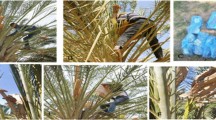Abstract
The production of fruits and seeds of many crops is increased when external pollination occurs. Although self pollination is a widespread biological process in cultivated grapevines, there are still some uncertainties about the consequences of cross fertilization regarding productivity and quality of grapevines. Fertilization biology of grapevines becomes an essential issue when protected cultivation in particular is considered. The present investigations were therefore performed to clarify the possible effects of different pollination treatments on the agronomic features of ‘Perle de Csaba’ and ‘Trakya İlkeren’ table grape cultivars. Before the anthesis, clusters of self-pollination treatment were enclosed within cheesecloth frames to avoid extraneous pollination. For the free pollination group, flowers of twelve similar clusters were allowed to bloom and pollinate spontaneously, while hand pollination was performed by transporting the mixture of external pollens gathered from different cultivars at bloom stage. In ‘Perle de Csaba’ cultivar, hand pollination and free pollination treatments significantly increased the overall agronomic parameters on berry set rate, berry development, cluster size, seed weight and seed size in comparison to self pollination. Treatments had similar effects in ‘Trakya İlkeren’, except for a few parameters such as cluster length, berry diameter and seed thickness. Overall results indicated that cross pollination would considerably increase the quantity and quality of table grapes when cultivated under protected conditions such as glass or greenhouses.


Similar content being viewed by others
References
Ansari M, Davarynejad GH, Tornyai J, Nyeki J, Szabo Z, Soltesz M (2010) Effects of self- and crosspollination on fruit set and fruit quality of sour cherry cultivars. Int J Hortic Sci 16:31–36
Cholokashvili S, Chakhnashvili N (1926) Results of a study on Georgian grapevine. Agron Proc Georgian Exp 3:17–19
Ergul A, Marasali B (1997) Effects of pollination types on berry and seed set in grape cultivars. Tarım Bilim Derg 3:39–42
Filler DM, Luby JJ, Ascher PD (1994) Incongruity in the interspecific crosses of Vitis reproductive expression in the F1 grogeny. Euphytica 78:155–164
Fotiric M, Mulitinovic M, Nikolic D, Rakonjac V (2003) Pollinizer influence on berry and seed properties in grapevine cultivar ‘Bagrina’ (Vitis vinifera L.). Acta Hortic 603:775–777
Gurasashvili V, Vashakidze L (2004) Type of pollination and frequency of fruit-set of Georgian grapevine variety Gorula. J Probl Agric Sci 26:72–75
Kimura PH, Okamoto C, Hirano K (1998) The mode of pollination and stigma receptivity in ‘Vitis coignetiae Pull’. Am J Enol Vitic 49:1–5
Kumar K, Das B (1996) Studies on xenia in almond (Prunus dulcis Miller DA Webb). J Hortic Sci 71:545–549
Marasali B, Baydar NG (2001) Studies on flower types and pollination properties of some Vitis species and cultivars used as rootstocks. Turk J Agric For 25:393–399
McGovern PE, Rudolph HM (1996) The analytical and archaeological challenge of detecting ancient wine: two case studies from the ancient Near East. In: McGovern PE, Fleming SJ, Katz SH (eds) The origins and ancient history of wine. Gordon and Breach, New York, pp 57–67
Mullins MG, Bouquet A, Williams LE (1992) Biology of the Grapevine. Cambridge University Press, UK, p 239
O. I. V. (1983) Le code des caractères descriptifs des variétés et espèces de Vitis. Office International de la Vigne et du Vin, Paris
Okamoto G, Kuwamura T, Hirano K (2004) Effects of water deficit stress on leaf and berry ABA and berry ripening in Chardonnay grapevines. Vitis 43:15–17
Rivera D, Miralles B, Obón C, Carreńo E, Palazón JA (2007) Multivariate analysis of Vitis subgenus Vitis seed morphology. Vitis 46:158–167
Rombough L (2002) The grape grower. Chelsea Green, White River Junction, VT
Sabir A (2008) Ampelographic and molecular characterization of some grape cultivars and rootstocks (Unpublished Ph.D thesis, Univ. of Cukurova, Turkey, 154p)
Sabir A (2011) Influences of self- and cross-pollinations on berry set, seed characteristics and germination progress of grape (Vitis vinifera cv. ‘Italia’). Int J Agric Biol 13:591–594
Sabir A (2013) Improvement of grafting efficiency in hard grafting grape Berlandieri hybrid rootstocks by plant growth-promoting rhizobacteria (PGPR). Sci Hortic 164:24–29
Sabir A (2015) Xenia and metaxenia in grapes: differences in berry and seed characteristics of maternal grape cv. ‘Narince’ (Vitis vinifera L.) as influenced by different pollen sources. Plant Biol 17:567–573
Sabir A, Sabir FK, Kara Z, Gayretli Y, Mohammed OJM, Jawshly AIM, Kus AD (2019) Berry set and quality response of soilless grown ‘Prima’ grapes to foliar and inflorescence pulverization of various substances under glasshouse condition. Erwerbs-Obstbau 61(Suppl 1):S47–S51
Sahin G (2006) Effects of different pollinizers on berry set with berry and seed features in Alphonse Lavallée (V. vinifera L.) (M.Sci Thesis, Univ. of Selcuk,Turkey, 40p)
Samaan LG, Taha MW, Hassan AH, Boraby MSE (1981) Pollination and serological studies on Egyptian grapes. Vitis 20:293–301
Shafique M, Khan AS, Malik AU, Shahid M, Rajwana IA, Saleem BA, Amin M, Ahmad I (2011) Influence of pollen source and pollination frequency on fruit drop, yield and quality of date palm (Phoenix dactylifera L.) cv. Dhakki. Pak J Bot 43:831–839
Staudt G (1999) Opening of flowers and time of anthesis in grapevines Vitis vinifera L. Vitis 38:15–20
Vashakidze L, Gogiava E, Bejuashviliu N (1982) The biological peculiarities of some Georgian grapevine varieties by breeding. In: Conference on ‘Productivity of Subtropical Crops’ Maxaradze-Anaseuli. Georgia
Zohary D, Hopf M (2000) Domestication of plants in the Old World, 3rd edn. Oxford University Press, New York, pp 151–159
Acknowledgements
This study was supported by the Scientific and Technological Research Council of Turkey (TÜBİTAK) as the graduate thesis of Seher Kilinc.
Author information
Authors and Affiliations
Corresponding author
Ethics declarations
Conflict of interest
A. Sabir, S. Kilinc and F. Sabir declare that they have no competing interests.
Rights and permissions
About this article
Cite this article
Sabir, A., Kilinc, S. & Sabir, F. Qualitative and Quantitative Responses of Early Ripening Table Grape Cultivars (Vitis vinifera L.) to Pollination Treatments under Controlled Growing Condition. Erwerbs-Obstbau 62 (Suppl 1), 75–80 (2020). https://doi.org/10.1007/s10341-020-00499-6
Received:
Accepted:
Published:
Issue Date:
DOI: https://doi.org/10.1007/s10341-020-00499-6




